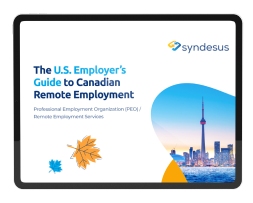For years, California’s Silicon Valley was the place to be for tech start-ups and behemoths alike. Tech companies of all sizes flocked there to scale their operations, and many believed you needed a Bay Area address in order to raise big investor bucks.
Well, that isn’t the case any longer.
Canadian cities have become some of North America’s fastest growing tech hubs. Canada’s transition to tech titan is thanks to world class universities and engineering programs, a highly-skilled talent pool, and flexible immigration policies. American companies have noticed Canada’s tech boom, and many major tech players now have offices in Canada.
The migration of American tech companies that have expanded north across the Canadian border is being led by big names — Amazon, Salesforce, Netflix and others.
Small US tech companies have surely been paying attention to this trend, but many might be thinking, “We’re too small to consider an international expansion.”
The reality is that smaller companies can expand into Canada too, and it’s actually easier than you might think.
So let’s dive into which big US tech companies have paved the way, why a small tech company might want to do the same thing, and how to do it.
3 of the biggest US tech companies that have opened offices in Canada
Canada’s tech sector is growing nationwide, but two cities have been leading the pack: Toronto and Vancouver.
Both cities have become a huge draw for talented tech workers and the companies that want to hire them.
Many US companies have expanded into Canada, but the ones making headlines are true tech giants.
#1. Amazon
Amazon — one of the largest tech companies in the world — first established a presence in Vancouver in 2013, but it’s been growing its footprint in Canada.
After Amazon’s HQ2 in New York City was canceled, the tech giant announced that the jobs slated for the canceled HQ2 in New York City will be redistributed across its existing tech hubs in North America.
#2. Salesforce
After unveiling its Canadian office, Salesforce founder, chairman, and co-CEO, Marc Benioff pledged a $2B investment in the company’s Canadian expansion, bringing with it a promise of increased jobs, real estate, and data center capacity for the company’s Toronto and Vancouver locations.
E-commerce platforms are also making the move, with Wayfair recently announcing that it is opening an engineering office in Toronto and plans to hire 200 roles.
#3. Netflix
Lastly, Netflix recently announced that they’ll open a new office in Canada which will be in addition to Netflix’s existing production hub in Toronto.
As you can see, all sorts of companies are moving to Canada — e-commerce, SaaS, media streaming, and more. But why has Canada become such a popular destination for US tech companies?
2 major reasons why Canada’s tech scene is booming and how small US tech companies can take advantage of it too
The secret to Canada’s tech success is actually quite simple: great tech-focused universities, and flexible immigration policies like the Global Talent Stream and British Columbia’s startup visa program.
Reason #1: Tech-focused education
Education forms the foundation for the quality of tech labor in Canada and several of Canada’s post-secondary schools have been rated among the world’s best universities.
Post-secondary institutions in Vancouver issued 12,944 tech degrees between 2015 and 2019, and 24,200 tech jobs were added in the city from 2016 to 2020, which represents a net “brain gain” of 11,256 tech workers.
In contrast, fewer international students are enrolling in American universities and fewer American students are graduating with STEM degrees.
All of this means that there are fewer STEM graduates for US companies to hire, which is a big, important reason to look at Canada as a source of skilled labor.
Reason #2: Flexible immigration policies
Canada has proactively been building programs to take advantage of this opportunity. Their Global Talent Stream (GTS) program, for example, was created specifically to ease the immigration process for highly skilled tech workers.
The GTS program expedites and eases the processing time for visa and work permit applications for foreign nationals who possess unique talents or are highly skilled.
The typical timelines are 10 business days to assess applications and 14 business days to process work permits for qualified workers.
In addition to GTS, Canada offers more than 100 different immigration pathways including a number of Provincial Nominee Programs (PNP).
PNPs give Canada’s provinces and territories the power to develop their own immigration programs as a way to attract workers with specific skills.
Canada has a variety of immigration programs for your tech employees
The BC Provincial Nominee Program Tech Pilot, for example, has become a popular way for top-quality tech entrepreneurs and skilled workers from around the globe to foster British Columbia’s burgeoning technology sector.
Canada’s Global Talent Stream and Provincial Nominee Programs are excellent immigration pathways specially designed to fast-track the best and brightest candidates into Canada.
All of this adds up to a highly skilled Canadian workforce that includes 900,000 tech talent workers.
This easy access to foreign professionals is very tempting to tech companies both big and small.
But if you’re a small business or early-stage start-up, the idea of expanding internationally can be overwhelming.
Fortunately, it doesn’t have to be.
The intra-company transfer program allows key employees of a company that is looking to open up a new office in Canada, to be able to move to and work in Canada.
Bringing international employees to Canada as intra-company transferees allows employers to skip getting a Labour Market Impact Assessment as well.
So if you’re a small business and you’re thinking, “I’d love to expand my tech team in Canada and take advantage of all these great things, but I can’t afford / don’t have time / don’t know how to do it,” here’s your answer: work with a professional employer organization (PEO).
A PEO is the best way for a small company to stake its claim in Canada
Instead of opening up an entire office, which can be expensive, complicated, and time-consuming, you can use a professional employer organization — commonly referred to as a PEO.
A PEO gives US-based companies the power to easily hire in Canada. The PEO handles the Canadian hiring process and legally hires the candidate in Canada, but the US company pays the salary (via the PEO) and manages the day-to-day job — it will feel like a completely normal remote job.
While the US employer retains essential management over the employee, the PEO can cover human resource tasks like providing an offer letter, hiring, payment, drug testing, family leave, and more.
Simply put, your American employees can move to Canada and the PEO will hire them on your behalf.
Or, if your valuable tech employees are at risk of losing their work visa, and your employee is tired of the green card backlog, a PEO like Syndesus can sponsor a foreign national to work with you in Canada remotely instead of via the often difficult H-1B visa program.
Yes, it’s as easy as it sounds.
Ready to plan your Canadian expansion? Syndesus can help!
Syndesus helps US tech companies expand to and hire in Canada
Hiring workers remotely through a PEO like Syndesus means that the immigration, payroll, and even finding talent and other administrative processes are taken care of for you while you focus on expanding your talented workforce and moving your company forward.
Syndesus enables US tech companies to move their existing tech workers from the US to Canada, or hire new tech workers in Canada, taking care of the visa sponsorship, as well. With Syndesus, Canada is your tech company’s next remote office.
Want to hear more? Book a consultation to chat about your hiring situation.
Syndesus can help you expand your team with the world’s most talented technology professionals but without the world’s most frustrating immigration system.




